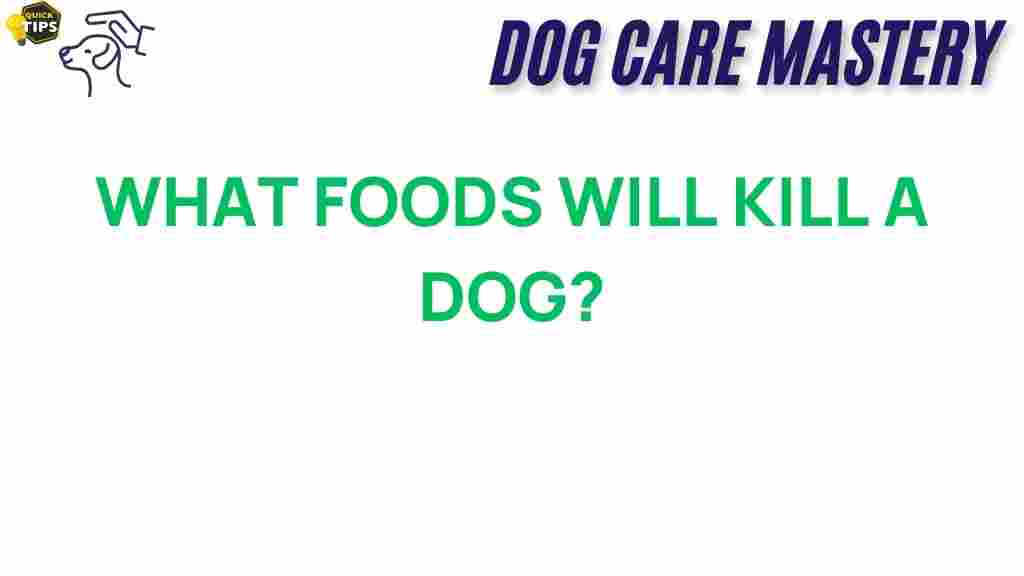Dog Safety: Unveiling the Hidden Dangers
As a dog owner, ensuring the safety and well-being of your furry friend is a top priority. One of the most crucial aspects of dog safety is being aware of the foods that can poison your dog. It’s easy to assume that what we enjoy is also safe for our pets, but many common foods can be toxic to dogs. In this article, we will explore these hidden dangers, how to recognize the signs of poisoning, and what you can do to protect your dog.
Understanding Why Certain Foods Are Toxic
Dogs have different metabolic systems compared to humans, making them sensitive to certain substances that are otherwise harmless to us. Factors that contribute to food toxicity in dogs include:
- Size and breed: Smaller dogs may be more susceptible to toxic effects because of their size.
- Age: Puppies and older dogs may have weaker immune systems.
- Health conditions: Dogs with pre-existing health issues may react more severely to certain foods.
Common Foods That Can Poison Your Dog
Here are some of the most common foods that can pose a serious risk to your dog’s health:
1. Chocolate
Chocolate contains theobromine and caffeine, both of which are toxic to dogs. Dark chocolate is particularly dangerous due to its high theobromine content. Symptoms of chocolate poisoning include:
- Vomiting
- Diarrhea
- Increased heart rate
- Seizures
2. Grapes and Raisins
Grapes and their dried form, raisins, can cause kidney failure in dogs. Even small amounts can be harmful, and symptoms may include:
- Vomiting
- Diarrhea
- Lethargy
- Loss of appetite
3. Onions and Garlic
Both onions and garlic contain compounds that can damage red blood cells in dogs, leading to anemia. Symptoms may not appear immediately and can include:
- Weakness
- Vomiting
- Breathlessness
- Orange-tinged urine
4. Alcohol
Alcohol can have devastating effects on dogs, including respiratory failure and coma. Even small amounts can be dangerous. Symptoms include:
- Vomiting
- Disorientation
- Seizures
- Low body temperature
5. Xylitol
This artificial sweetener, often found in sugar-free gum and baked goods, can cause a rapid release of insulin in dogs, leading to hypoglycemia (low blood sugar). Symptoms include:
- Vomiting
- Lethargy
- Seizures
- Loss of coordination
Step-by-Step: What to Do If Your Dog Ingests Poisonous Food
If you suspect your dog has ingested something toxic, follow these steps:
- Stay Calm: Your dog can pick up on your emotions. Stay calm to avoid further stressing your pet.
- Assess the Situation: Identify what your dog has eaten, how much, and when it occurred.
- Contact Your Veterinarian: Immediately call your vet or an emergency animal poison control hotline. Provide them with all necessary information.
- Do Not Induce Vomiting: Unless instructed by a vet, do not attempt to induce vomiting as it may cause more harm.
- Follow Veterinary Advice: If advised, take your dog to the clinic for further evaluation and treatment.
Recognizing Symptoms of Food Poisoning
It’s crucial to be able to recognize the signs of food poisoning, as they can vary depending on the substance ingested. Common symptoms include:
- Vomiting
- Diarrhea
- Excessive drooling
- Weakness or lethargy
- Seizures
- Abdominal pain
- Loss of appetite
If you notice any of these symptoms, seek veterinary care immediately. Early intervention can be vital for your dog’s recovery.
Preventing Food Poisoning in Dogs
Prevention is key when it comes to dog safety. Here are some effective strategies to keep your dog safe from toxic foods:
- Educate Yourself: Familiarize yourself with foods that are toxic to dogs.
- Secure Food Storage: Keep human foods locked away in cabinets and out of reach.
- Be Cautious at Parties: If you’re hosting or attending gatherings, keep an eye on your dog and inform guests of the dangers of feeding them human food.
- Provide Proper Dog Food: Ensure your dog is eating a balanced diet specifically formulated for canines.
- Regular Vet Check-ups: Routine veterinary care helps ensure your dog is healthy and can help catch any potential issues early.
Troubleshooting Tips for Dog Owners
Even with the best precautions, accidents can happen. Here are some troubleshooting tips to help you manage potential poisoning:
- Keep Poison Control Numbers Handy: Write down the contact information for your vet and a local animal poison control center.
- Monitor Your Dog: Keep an eye on your dog’s behavior and health, especially after they’ve eaten something new.
- Report Any Changes: If you notice unusual behavior or symptoms, report them to your vet immediately.
- Document Incidents: Keep a record of any food your dog has ingested, along with the time and amount.
When in Doubt, Consult the Experts
If you’re ever uncertain about what’s safe for your dog, consulting your veterinarian is always the best course of action. They can provide tailored advice based on your dog’s specific health needs and dietary requirements. Additionally, for more comprehensive information on pet safety, you can visit The American Society for the Prevention of Cruelty to Animals (ASPCA).
Conclusion: Prioritizing Dog Safety
Understanding the hidden dangers in our kitchens is essential for every dog owner. By educating ourselves about toxic foods and taking proactive measures, we can significantly enhance the safety and well-being of our beloved pets. Remember, dog safety is not just about what you feed your dog, but also about being vigilant and informed. Always consult your vet when in doubt, and enjoy many safe and happy moments with your furry friend!
For additional resources on dog safety and preventive care, feel free to explore our other articles on this site or reach out to professionals in the field.
This article is in the category Safety and created by dogcaremastery Team
